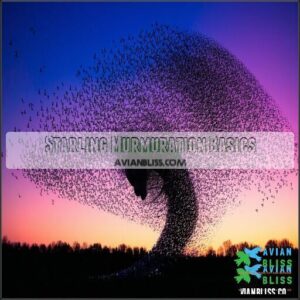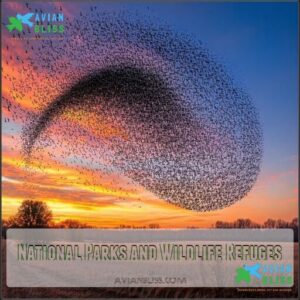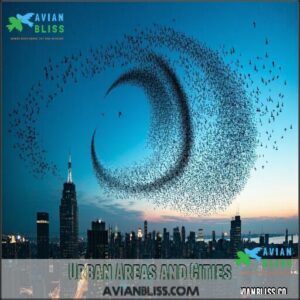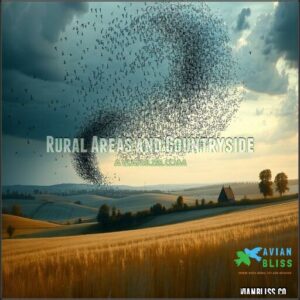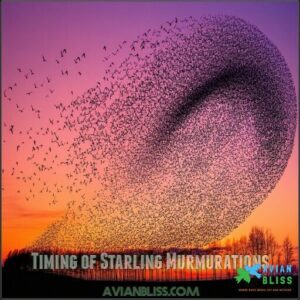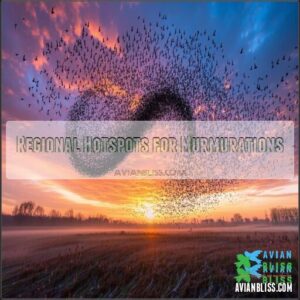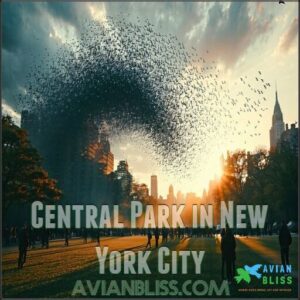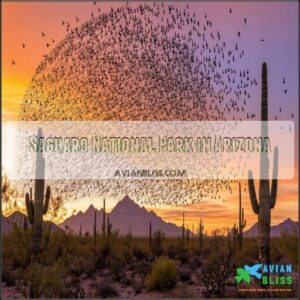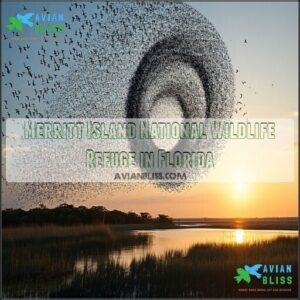This site is supported by our readers. We may earn a commission, at no cost to you, if you purchase through links.

Prime viewing spots include Central Park (NYC), Merritt Island Wildlife Refuge (Florida), and Saguaro National Park (Arizona).
Visit at dusk when thousands of birds perform their mesmerizing sky dance—like living ink swirling across a canvas.
The best times are October through February, especially on calm evenings near large roosting sites in urban parks or wildlife refuges.
Bundle up and arrive 30-45 minutes before sunset to claim your spot, and be prepared for Nature’s greatest aerial show to happen right before your eyes, no ticket required—just patience and good timing, which is a truly living experience.
Table Of Contents
- Key Takeaways
- Starling Murmuration Basics
- Where to See Starling Murmurations
- Best Locations in USA
- Timing of Starling Murmurations
- Regional Hotspots for Murmurations
- Tips for Observing Starling Murmurations
- Popular Starling Murmuration Sites
- Frequently Asked Questions (FAQs)
- Where can you see a Starling Murmuration?
- Where can I see starlings?
- When is the best time to see a Starling Murmuration?
- When does a starling murmur take place?
- When do Starling Murmurations take place?
- What is a Starling Murmuration?
- What Time of Year Are Starling Murmurations Most Active?
- What Types of Food Do Starlings Eat?
- Are There Any Humane Methods of Controlling Starling Populations?
- What is the Difference Between Starling Murmurations and Other Bird Gatherings?
- Conclusion
Key Takeaways
- You’ll find the best starling murmurations from October through February across the USA, with prime viewing times occurring 30-45 minutes before sunset when thousands of birds perform their synchronized aerial dance.
- Popular viewing locations include Central Park (NYC), Merritt Island Wildlife Refuge (Florida), and Saguaro National Park (Arizona), offering diverse settings from urban landscapes to natural reserves.
- For the best experience, bring essential gear like binoculars, a camera with telephoto lens, and warm clothing, as murmurations typically occur during cooler months and can last 15-20 minutes.
- You’ll see these mesmerizing displays in both East and West Coast regions, with each location offering unique backdrops – from NYC’s skyline to Arizona’s iconic cacti – making this natural phenomenon accessible throughout the country.
Starling Murmuration Basics
You’ve probably seen videos of starlings creating breathtaking, swirling patterns in the sky, but do you know what’s behind the spectacle?
A murmuration is a massive flock of these birds moving in perfect unison, guided by simple rules that keep them safe and synchronized.
Definition and Characteristics
Starling murmurations are dazzling aerial displays where thousands of starlings move in synchronized, cloud-like patterns, creating a mesmerizing dance in the sky.
A breathtaking ballet of thousands, starlings weave cloud-like patterns, painting the twilight sky with mesmerizing motion.
This collective movement—resembling a living, breathing organism—is a hallmark of starling behavior.
The murmuration sound, a soft hum of beating wings, adds to the spectacle, making these flocking behaviors a must-see wildlife phenomenon in the starling murmuration USA experience, with a truly mesmerizing dance.
Scientific Explanations and Theories
Imagine birds performing synchronized sky ballet—scientists reveal fascinating insights! Starlings use collective behavior with "collision avoidance" by adjusting to neighbors’ moves.
The "rule of seven" keeps flock dynamics stable, ensuring smooth movement. "Predator confusion"? Their swirling flocks baffle hunters like hawks. Some even speculate "morphic resonance" links them together.
- Key behaviors: Swarm unity, efficient information exchange, neighbor-aligned flight paths
- Benefits: Safety, warmth, survival
- Mechanics: Each bird reacts instinctively within seconds
Purpose and Behavior
You’ve heard about their amazing flight patterns, but there’s more to starling murmuration than beauty.
These synchronized displays are a masterclass in predator avoidance, where coordinated flight keeps hawks guessing.
Starlings benefit from safety in numbers, swapping essential information while staying warm, too.
Each individual’s actions contribute to the flock’s collective motion—a behavior rooted in both survival and community.
Where to See Starling Murmurations
If you’re curious about where to see breathtaking displays of starling murmurations in the USA, you’re in for a treat.
These mesmerizing formations can be spotted in both rural serenity and urban convenience.
Popular murmuration hotspots include wildlife refuges, national parks, and even cityscapes like San Rafael, California, or Central Park in New York City.
These spots provide accessible spaces for spectators, but always prioritize viewing etiquette—respect nature and others sharing the experience.
Pack comfortable shoes and a camera to capture memory-worthy shots.
Local guides can be handy if you’re unfamiliar with an area.
Whether whispered over woodlands or above bustling parking lots, these displays promise unforgettable visual moments.
To enhance your birding experience, consider visiting Virginia’s birding trails.
There’s really no wrong place to watch—just linger and look.
Best Locations in USA
You don’t have to travel far to witness the incredible phenomenon of starling murmurations in the USA.
From bustling urban parks to serene wildlife refuges, these enchanting displays can be spotted across the country during cooler months.
National Parks and Wildlife Refuges
You’ll find breathtaking starling murmurations in wildlife refuges like Merritt Island (Florida) and Saguaro National Park (Arizona).
These spots, rich in Park Roost Sites and Protected Starling Habitats, attract bird watchers keen to witness Murmuration Migration Patterns.
Refuge Bird Counts contribute to Refuge Conservation Efforts, enhancing nature tourism USA.
Murmuration locations USA showcase wildlife at its most awe-inspiring, with a focus on Refuge Conservation Efforts.
Urban Areas and Cities
Starling murmuration in urban areas can feel magical, with cityscape impact adding unexpected beauty.
Famous birdwatching locations in the USA include Central Park, San Rafael’s open-air parking lot, and Hudson Valley.
Urban roost sites face challenges like noise pollution and light pollution, yet these adaptable birds thrive.
Watching them turn city skies alive is an unforgettable sight.
These displays often peak during the cold winter months, creating a truly beautiful experience.
Rural Areas and Countryside
The countryside offers breathtaking views of starling murmurations, especially in open landscapes and grasslands.
These displays, driven by roosting ecology and winter foraging, often unfold in rural areas far from predators.
Open fields also support local economies through tourism and agriculture.
Explore these bird-watching locations for unforgettable experiences:
- Agricultural fields with leftover crops.
- Open grasslands near rivers or game reserves.
- Quiet farmland with limited human disturbance.
Timing of Starling Murmurations
You’ll catch the most stunning starling murmurations from late autumn to winter, typically between November and February.
Plan to arrive just before dusk, as these mesmerizing displays usually peak in the fading light of day, creating a truly unforgettable experience with stunning views.
Peak Season and Months
The starling murmuration season in the USA peaks during winter, particularly November through February.
Seasonal variations influence this breathtaking display, as starlings follow roosting patterns tied to colder months, with crisp evenings enhancing activity.
Prime months align with regional differences, so bundle up and head out—murmurations will warm your soul amidst the chill.
| Region | Prime Months | Weather Influence |
|---|---|---|
| East Coast | November–January | Crisp, clear nights |
| West Coast | December–February | Milder conditions |
| Midwest/Central | November–February | Frigid evenings |
Time of Day and Sunrise
Timing matters for catching starling murmuration USA displays, as they usually peak just before sunset or during the dawn spectacle.
Light conditions affect visibility, so aim to arrive early.
Here’s when to go:
- Dusk—45 minutes before sunset.
- Dawn—pre-sunrise activity starts early.
Stay nearby roosting spots.
Early risers enjoy rare quiet moments.
Dimming light can trigger hormonal changes in birds.
Weather Conditions and Forecast
Clear skies aren’t a must for a mesmerizing starling murmuration USA experience.
However, heavy rain or strong wind impacts their movement, scattering flocks.
Ideal conditions often include mild winter evenings with steady temperatures and light breezes.
Seasonal patterns favor high activity under calm, overcast skies.
Whether near starling murmuration hotspots or wondering where to see starlings, check local weather for accuracy.
Regional Hotspots for Murmurations
You’ll find starling murmurations lighting up skies from the East Coast to the West, with each region offering its own unique viewing spots.
These incredible displays are most common in wide-open spaces like national parks, wildlife refuges, and rural areas.
East Coast and Atlantic Regions
The East Coast is rich with starling murmuration hotspots, offering unforgettable birding destinations.
Along the Atlantic Flyway, check out these seasonal wonders:
- Acadia National Park: Coastal habitats perfect for bird watching.
- Central Park: Urban murmurations amid NYC’s skyline.
- Reed Beds, Florida: Stars of the seasonal variations.
- Chesapeake Bay: Local conservation continues protecting starling roosts.
Pack binoculars—nature’s show awaits!
West Coast and Pacific Regions
Looking west from the Atlantic seaboard, the Pacific coast offers equally mesmerizing starling displays.
You’ll find spectacular California murmurations throughout the Bay Area, particularly near San Francisco.
| Location | Best Viewing Time | Special Features |
|---|---|---|
| San Francisco Bay Area | Dusk (5pm) | Urban backdrop |
| Astoria-Megler Bridge | Late afternoon | Over-water patterns |
| Salem’s Baskett Slough | Fall season | Vineyard setting |
The Treasure Valley’s west end delivers consistent sightings in late summer, while Pacific Northwest coastal habitats provide perfect starling gathering points during migration patterns.
Midwest and Central Regions
During peak migration season, the Midwest and Central Regions transform into starling paradise.
Eagle Bluffs Conservation Area in Missouri offers prime viewing of these Prairie Roosts, while Treasure Valley’s agricultural areas showcase the dramatic impact these birds have on Great Plains ecosystems.
Illinois parks serve as Winter Havens for birding enthusiasts.
These routes are part of established migration routes and flyways.
For the best experience, arrive at dawn or dusk and bring binoculars—these Winter starling roosts won’t disappoint!
Tips for Observing Starling Murmurations
You’ll want to position yourself in open areas near roosting sites about 30 minutes before sunset when starlings begin their spectacular aerial dance.
Bringing binoculars and a comfortable chair will enhance your viewing experience of these mesmerizing formations that can include thousands of birds moving as one unified organism, creating a truly unified display.
Essential Gear and Equipment
To capture the magic of starling murmurations, pack binoculars for a closer view and a sturdy tripod for steady shots.
Camera gear, especially a telephoto lens, helps with photography in lowlight conditions. Wear warm clothing—it can get chilly!
Bring field guides to identify other birds nearby. For ideal viewing, consider high-powered birding optics.
Birdwatching gear like notepads or apps enhances the experience, making it more enjoyable and interactive with the use of field guides.
Safety Precautions and Guidelines
While you’ve packed your gear, don’t forget safety comes first when birdwatching.
Stand clear of trees during murmurations to avoid dropping hazards (starlings produce a lot of waste!).
Maintain distance from the flock to respect wildlife and reduce disease prevention concerns like Bird Flu.
Park in designated areas only, and consider safety in numbers by bringing companions—the same predator protection strategy starlings use works for humans too!
Photography and Videography Tips
Grab your camera gear before the starlings take flight to capture these mesmerizing aerial ballets. For successful murmuration photography, preparation is key.
- Use a fast shutter speed (1/1000s or faster) to freeze individual birds while maintaining flock patterns
- Choose a telephoto lens (200-600mm range) for distant murmurations
- Shoot in burst mode to catch dynamic shape changes
- Underexpose slightly to preserve silhouette details against evening skies
Using the correct settings, you can achieve high quality images.
Popular Starling Murmuration Sites
You’ll find America’s most spectacular starling shows at key locations where thousands of birds gather to perform their synchronized aerial ballet.
Central Park in New York City, Saguaro National Park in Arizona, and Merritt Island Wildlife Refuge in Florida offer prime viewing spots where you can witness these mesmerizing natural performances during winter months.
Central Park in New York City
You’ll find history in motion at Central Park, where starling murmurations began in the 1890s.
Now it’s a premier starling murmuration USA viewing spot. Local starling roosts form near the American Museum of Natural History, creating a living connection to their introduction.
| Viewing Area | Best Time | Murmuration Spectators Tip |
|---|---|---|
| Great Lawn | Sunset Nov-Feb | Bring binoculars |
| Sheep Meadow | Late afternoon | Arrive 30 minutes early |
| Reservoir | Winter evenings | Check Urban Bird Migration patterns |
| North Meadow | Dusk | Follow Park Viewing Tips online |
| Central Park Ecology Center | Year-round info | Join guided bird watching tours |
Saguaro National Park in Arizona
While Central Park offers urban bird watching, Southeastern Arizona’s Saguaro National Park provides a stunning desert backdrop for starling murmurations.
You’ll find these mesmerizing avian displays among the iconic cacti that define the park’s unique ecology.
The park’s 15 miles of trails give you multiple vantage points to witness this Arizona wildlife phenomenon.
Nearby Cave Creek Canyon and Patagonia-Sonoita Creek Preserve are also excellent spots if you’re hunting for desert murmurations.
Merritt Island National Wildlife Refuge in Florida
While exploring the 140,000-acre Merritt Island National Wildlife Refuge, you’ll witness spectacular Space Coast murmurations every sunset.
This premier birding destination USA showcases thousands of starlings dancing above the Indian River Lagoon ecosystem.
Florida’s refuge birdlife includes over 1,500 species, with Black Point Wildlife Drive offering perfect spots for wildlife photography.
Visitor information suggests arriving early to secure prime viewing locations for this natural spectacle.
Frequently Asked Questions (FAQs)
Where can you see a Starling Murmuration?
You’ll find nature’s most breathtaking aerial ballet at locations like Central Park (NYC), Saguaro National Park (AZ), and Merritt Island (FL).
The best viewing times are dusk hours during fall and winter months, with breathtaking aerial displays.
Where can I see starlings?
Like nature’s own ballet in the sky, you’ll spot starlings at Central Park (NYC), Saguaro National Park (AZ), Cave Creek Canyon, Merritt Island NWR (FL), Higbee Beach (NJ), and Bosque del Apache NWR (NM).
When is the best time to see a Starling Murmuration?
You’ll experience the best starling murmurations from November through February, just before sunset.
These mesmerizing aerial ballets typically begin around 5 p.m., lasting 15-20 minutes as thousands of birds prepare for nighttime roosting.
When does a starling murmur take place?
You’ll typically see starling murmurations from autumn through winter (September to February), just before dusk.
These displays occur daily, lasting 15-20 minutes as thousands of birds gather to roost for the night.
When do Starling Murmurations take place?
You’ll find starling murmurations primarily during autumn and winter months (November-February), just before dusk.
They’ll perform their aerial ballet for about 15-20 minutes as they prepare to settle into their communal roosts.
What is a Starling Murmuration?
Just as you gaze skyward, you’ll witness a starling murmuration – a breathtaking aerial display where thousands of birds fly in synchronized, shape-shifting patterns.
They’re creating living sculptures while protecting themselves from predators.
What Time of Year Are Starling Murmurations Most Active?
Starling murmurations peak between November and February across the USA.
You’ll spot these mesmerizing aerial displays primarily at dusk, when thousands of birds gather before roosting during the cold winter months.
What Types of Food Do Starlings Eat?
A single starling can devour up to 200 insects per day.
You’ll find these adaptable birds eating berries, seeds, insects, earthworms, and even kitchen scraps – making them both pests and pest controllers.
Are There Any Humane Methods of Controlling Starling Populations?
You can use habitat modification by blocking cavities, apply EPA-approved liquid repellents, install visual and audio deterrents, secure trash, and use humane traps when necessary.
These methods discourage starlings without harming them or other wildlife.
What is the Difference Between Starling Murmurations and Other Bird Gatherings?
Unlike random bird flocks, you’ll notice starling murmurations form incredibly dense, synchronized patterns with precise coordination.
They’re unique for their complex wave-like movements, shape-shifting clouds, and the signature "whooshing" sound created by thousands of wings, showcasing their ability to create incredibly dense patterns.
Conclusion
Witnessing a starling murmuration in the USA leaves you suspended between awe and disbelief as thousands of birds move as one fluid entity.
Whether you’re watching from Central Park’s urban landscape or Merritt Island’s natural wetlands, these aerial ballets create memories that linger long after sunset.
Pack binoculars, dress warmly, and arrive early at these prime locations to see Nature’s most spectacular free show—you just need to know where to see starling murmurations in the USA.
- http://pittvillehistory.org.uk/bios/Selous5571.html
- https://www.scientificamerican.com/article/ruperts-resonance/
- https://www.bbc.com/news/av/uk-england-leeds-55221885
- https://www.nationalgeographic.com/animals/article/these-birds-flock-in-mesmerizing-swarms-why-is-still-a-mystery
- https://twitter.com/hashtag/murmuration?src=hash&ref_src=twsrc%5Etfw

